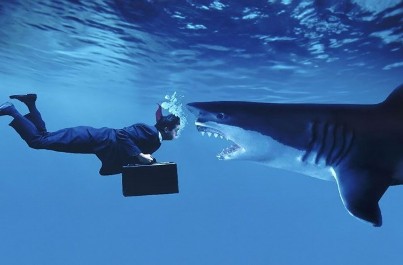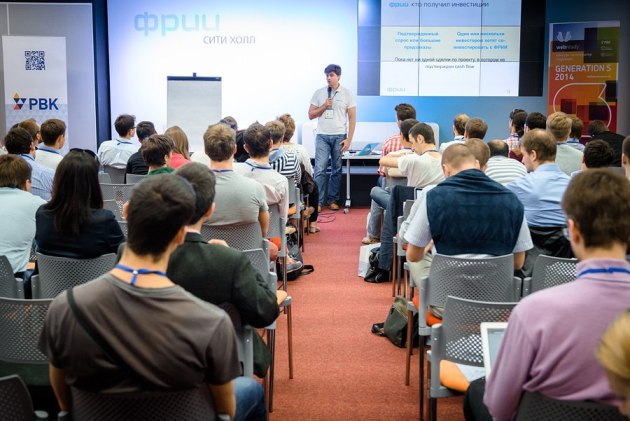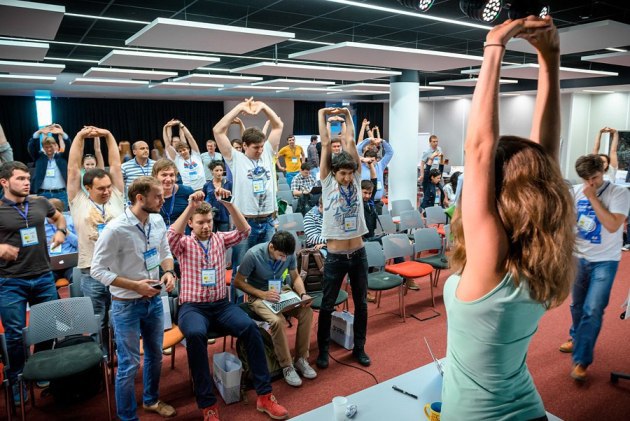What should a startup do in order to survive?
 In our previous blog post, we talked about the SHOPPILOT project ( SHOPPILOT Project History: From Fakap to Startup ). We met with them being in the Accelerator of the IIDF. This time we want to share the knowledge that the learning process in accelerators gives. We will tell you about how in 3 days we were given the basics of start-up on the Web Ready GenerationS 2014 program, which was held on the basis of the IIDF . From this article, you can find out what stages a startup is going through before becoming a business, how best to prescribe a business model for a project to attract investment and a few life hacks to help a startup survive. First, make a little "bored" over the theory, and then "cheer" with real cases.
In our previous blog post, we talked about the SHOPPILOT project ( SHOPPILOT Project History: From Fakap to Startup ). We met with them being in the Accelerator of the IIDF. This time we want to share the knowledge that the learning process in accelerators gives. We will tell you about how in 3 days we were given the basics of start-up on the Web Ready GenerationS 2014 program, which was held on the basis of the IIDF . From this article, you can find out what stages a startup is going through before becoming a business, how best to prescribe a business model for a project to attract investment and a few life hacks to help a startup survive. First, make a little "bored" over the theory, and then "cheer" with real cases.On the first day of training, the director of accelerated and educational programs of the IIDF Dmitry Kalayev talked about how a startup can calculate the amount of necessary investments for an investor, what to do if the project has a complex business model, and also dwells on other things useful for a novice entrepreneur, reinforcing the theoretical part practical cases of the IIDF Accelerator projects.
One of the main tenets is: a startup is not a business. You can call it a business in the bud, but it is very likely that nothing good will develop out of it. To understand whether a profitable business can turn out of an idea at all, a startup needs to be driven out in several stages.
In the presentation of Dmitry Kalayev there is such a picture:

The first two stages of a startup according to this methodology arehypothesis and testing . Moreover, if during the testing process the initial idea is not confirmed, then the startup has to do a pivot - a U-turn, build a new hypothesis and test it again, and so on, until it turns out to be successful. A hypothesis, in essence, is a search for a business model in which an entrepreneur must confirm that there is such a problem, that his project helps to solve it, and that there is a solvent audience that really needs it. The main evidence is the purchase and / or installation of the product by customers.
During testingthe viability of the project’s economy is checked, here we must confirm that it is possible to build a business on the product. The result of testing should be such a unit economy of the product in which we spend more than 3 times less on attracting a client than we earn on it (for more details, see the article " Growth Hacking: How to make more money using metrics correctly ") . The economy also needs to be tested for its ability to scale.
If all goes well, the pumping process beginstraffic to the project to increase the customer base. At this stage, it is already possible to attract seed investments. Between stages of testing and pumping is a crucial moment for a startup. The first two stages differ from the third in several respects. Firstly, at first the team often does not have clearly defined roles, all team members can perform any functions. Only in the third stage do team members usually have clearly defined areas of responsibility. Secondly, mistakes in the first two stages are even good, they allow you to better understand the product, business, concept. Plus, the losses from them are very small. In the process of pumping the same fakapy are already much more expensive. And thirdly, when the economy is confirmed, the business model is clearly defined, the project is already starting to realize its main mission - to make money.
In the IIDF, the business model of each startup is described in several components based on the IIDF Lean Canvas Model methodology , created thanks to IIDF 's own practice and the models of A. Osterwalder, E. Maurya and RIS Ventures, which have long been known on the market. The components of this IIDF model are:
• problem,
• technology,
• product,
• market,
• channels,
• “sales funnel”,
• customers,
• product economics.
The simplest business models are known to all: b2b, b2c, b2g, more complex b2b2c.
But many companies are forced to operate in several markets and target segments at once, which makes their business model two or more times more difficult. An example from the past accelerator kit: E-transport(a mobile application that shows in real time when a particular bus or tram arrives at this stop). Their customers are individuals who install the application for free, and legal entities as advertisers who sell this audience. They have different channels, different economies. In cooperation with individuals, it can be planned unprofitable, but at the expense of advertisers the company covers these costs. According to this model, Twitter, Facebook, and so on live: they give us their services for free, but they sell us to us as an audience for advertisers. Such companies have to work on two fronts, as a result, ETransport has two business models: for individuals with their own channels and the cost of attracting a client, for advertisers with other channels and another economy.
Another case of a complex business model Dmitry talked about: SimpleOrder- a system for automating the activities of hostels and small hotels (from 10 to 50 rooms), in the basic version - free. But when the hotel owner uses it for about a month, the company offers a paid service to automatically update the available number of rooms on Ostrovok.ru, Booking.com and other booking sites. And it works, because there are frequent situations of re-booking the same number on different sites. A man will come, he will need to be settled, an awkward situation may come out, and most importantly the hotel, which allowed such a mistake, by agreement with sites like booking.com, is responsible for placing the client, which can lead to direct and quite significant losses. The top component of the business model is lead generation: hotels easily agree to use the free service,
Speech by Dmitry Kalayev at Web Ready:

What should startups with such a model know?
It will not be easy for you. When there is just a product that you directly sell and take money, the hypothesis on this cycle can be checked very quickly. When this is a complex model - first you need to generate leads, then transfer them to someone else, and generally someone else will pay. While the whole chain develops, quite a lot of time will pass, and in the end the result may be unsuccessful. Have to go through all over again. Life hack from Dmitry: you just need to understand which of these models to test in the first place, focus on it, and emulate the remaining parts of the business model manually (for example, instead of making an automated contact transfer interface to a car dealer, make a call with a living person).
An example from the first set of the IIDF accelerator is the Online Dealer project (a service for booking new cars from official car dealers). The hypothesis was this: car dealers are most likely willing to buy leads - to pay for attracting a person for a test drive. The service was a certain widget with specific car models; they wanted to hang it on portals like Avito.ru , Auto.ru. To test this obvious hypothesis, it was necessary to agree with dealers and portals. In time, it took 2.5 months, that is, two weeks before the end of the acceleration cycle, they just started testing. From the client, they received their first money only when the acceleration was already over. What conclusions can be drawn? To understand that dealers are willing to pay for attracting leads for a test drive, it was possible with the help of Customer Development - just by talking to them. When testing a hypothesis, it is necessary to correctly determine exactly the place that really needs to be checked so as not to lose a lot of time for nothing.
Consider the components of a business model such as channels and the market .
Channels are not only advertising places, but also ways of communication with customers, their attraction, as well as means aimed at this. It can be both personal sales and targeted advertising. It is necessary to prescribe channels for attracting customers, first of all, for the investor: he wants to know what he is giving money for.
For example, there is a Yandex.Direct channel, according to it we write down keywords, channel capacity, conversion, transition price, price for attracting one client, how much we will earn on this channel and the amount of investments that you need to attract to cover the channel. Then you can discuss it for a long time, look for ways to optimize. But in any case, if you explain where and why the money will go, it will cause investor confidence. To know the channel capacity and conversion, you need to work with funnels: if the channel capacity is 500,000 people, and there are only 5 buyers, something obviously happens wrong between these two numbers, this needs to be clarified. Maybe Yandex.Direct has the wrong message, or the benefits of the product are not disclosed on the landing page.
A few key points when creating a funnel:
1. It is not worth collecting all the channels of attraction in one funnel, otherwise an unrealistic picture will turn out that shows nothing: the average temperature in the hospital.
2. You need to go all the way for the site visitor: problem points can be hidden in the interface itself (registration does not work, disorientates the menu, etc.).
3. If not all figures are known so far, you can set the average market to calculate the project economy at least approximately.
For the investor, the correct calculation of the market is no less important than the miscalculation of the promotion channels and the funds necessary for them. There are three market sizes:
TAM (Total Available Market) - the total market size for similar products;
SAM(Served Available Market) - the available market volume, that is, the potential market, taking into account competitors who already work on it;
SOM (Serviceable Obtainable Market) - an achievable market volume, 100% of your turnover.
An example of incorrect market calculations. Several years ago, Dmitry, using his own money as a partner of the RedButton fund, was considering an investment in a rental service that they wanted to replicate. To remind you that this market is occupied by AirBnb, the guys replied that they had already done such a service six months ago and sold it, now they want to do it again. In an attempt to figure out how they did this, they were asked to count the markets. They estimated that the market for daily rent of apartments and cottages in Russia is $ 1.2 billion. They suggested that 15% of the market is booked via the Internet, SAM turned out to be about $ 200 million. And if you take some million-plus city, except Moscow and St. Petersburg, it’s make up no more than 10% of the market, and the maximum SOM is about $ 20 million. It would seem like normal money. But they forgot one nuance: the service earns on commission from 5 to 15%. It turns out that TAM is $ 129 million, potentially for the whole of Russia - $ 19 million, and in one city - a maximum of $ 2 million, for which I no longer want to fight. Moreover, in the field research process, it turned out that in this particular city less than 10% of real estate is booked via the Internet. The saddest thing is that most services with a similar situation continue to consider the same.

An interesting example is the dual market of the IIDF Accelerator graduate. EasyTen (a service that offers you to learn 10 foreign words every day) has discovered two audiences: application users and companies that can sell these users as customers — educational agencies, foreign language schools, tutoring centers, etc. Accordingly, a market that get in the end, it consists of two pieces: sell first solution for people who want to learn languages, building up a base, and then sell the people concerned agencies, in general, can get $ 1.7 billion.
Another important for the investor Pros: what they will be better than the competition. EasyTen rebuilt from competitors when communicating with investors as follows: to LinguaLeoto bring to the Spanish, Chinese, Portuguese and other markets, you need to spend a lot of time and money on localization and adaptation. Since EasyTen users only learn words in order to enter a new market, it takes almost a month to introduce new pairs of words.
There is another example of GeneGuard- This is a script that is embedded in a web service, and diagnoses hacker attacks and makes maximum efforts to prevent them. The guys thought their market was simple enough: people who have similar sites, and who probably need this, have only 200 million in the world, 6.7 million of which are willing to spend money on security. Every year, about 675 thousand companies already face attacks. They differentiated from competitors at the lowest price of this solution due to the maximum specialization in protecting the site from hackers. Other services in this area, in addition to doing this, monitor the site, and many other services, so the price of their maintenance is much more expensive.
New stories about the acceleration process and startup projects that we met here - read in future publications here and in ourblog on the site .
Only registered users can participate in the survey. Please come in.
Do you have experience in a startup?
- 10.3% Yes, I tried to open my project 23
- 27.3% Yes, I have my own project 61
- 13% Yes, I worked for a startup 29
- 38.5% No, but I would like 86
- 10.7% No, God forbid 24
